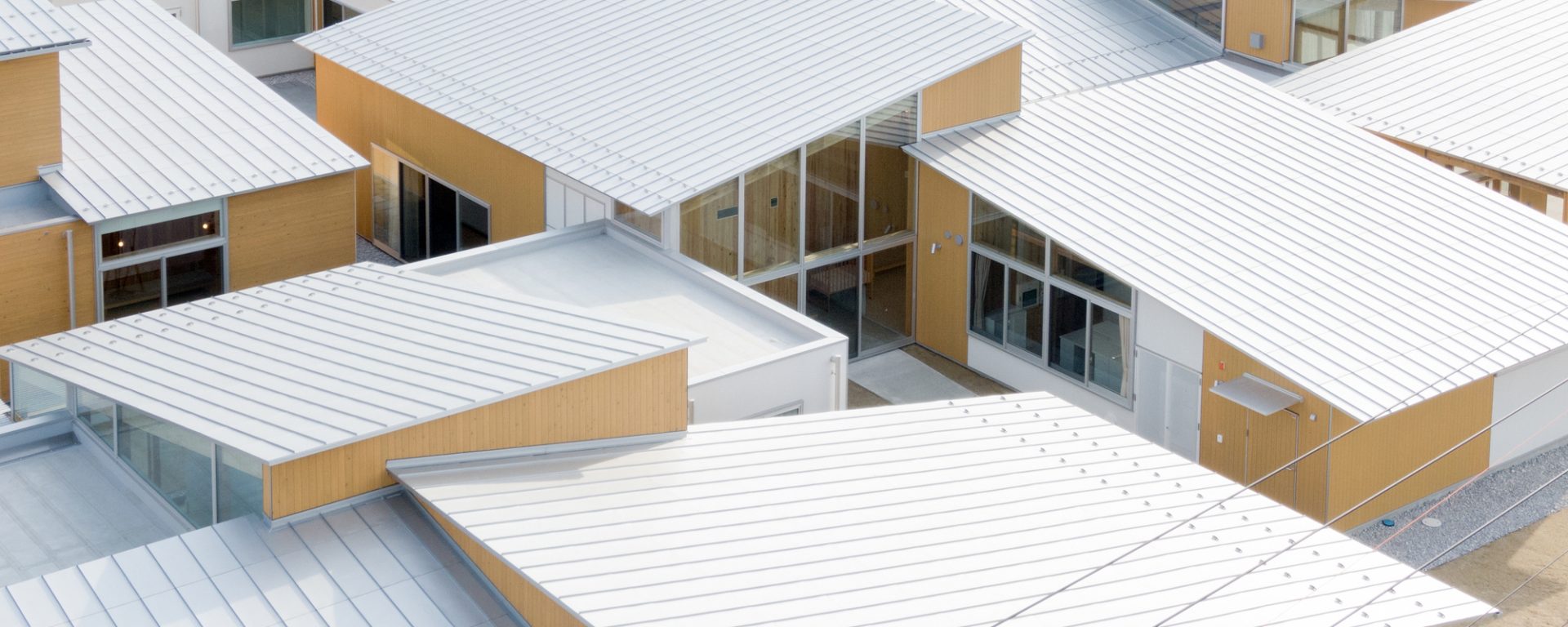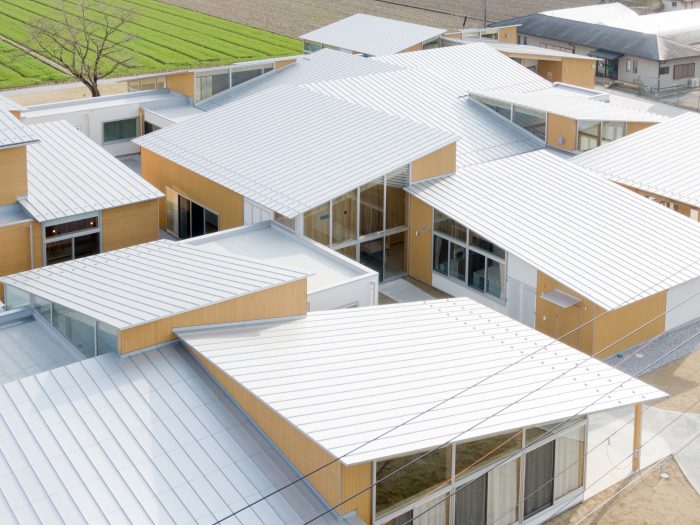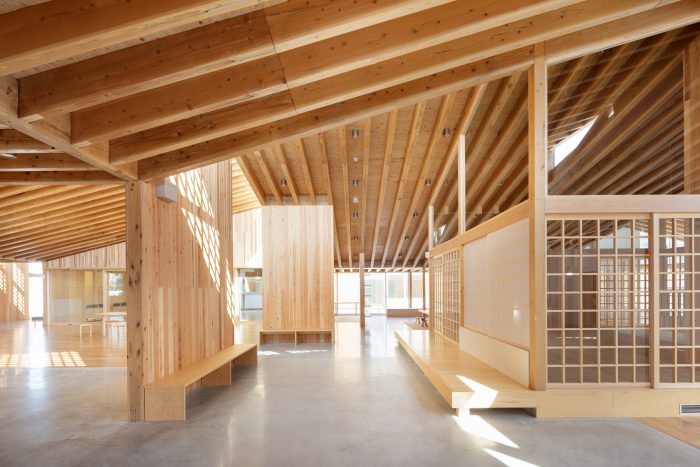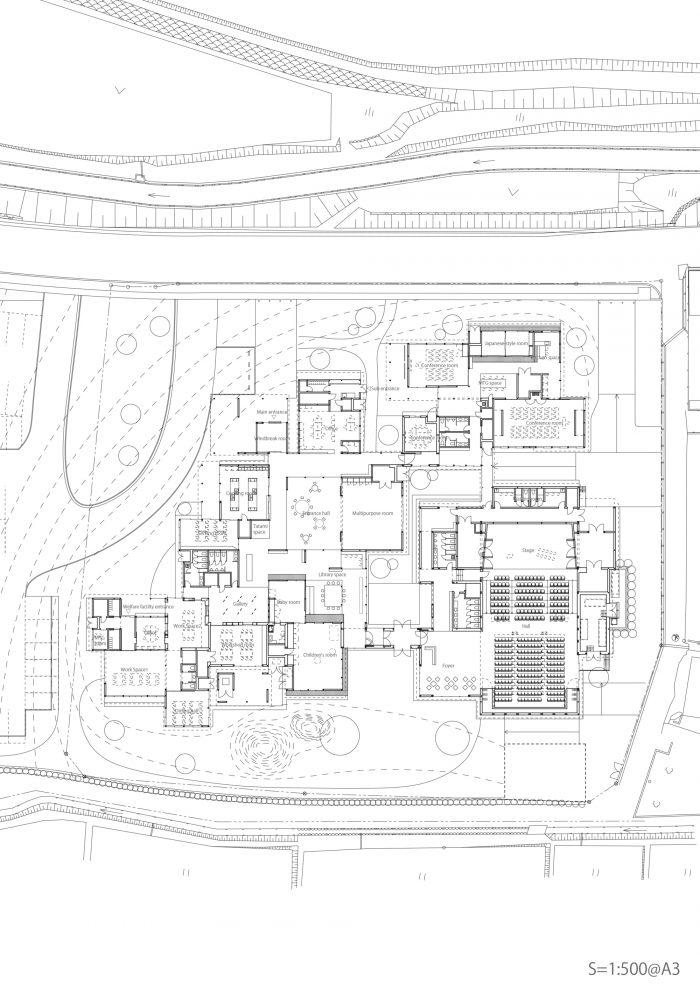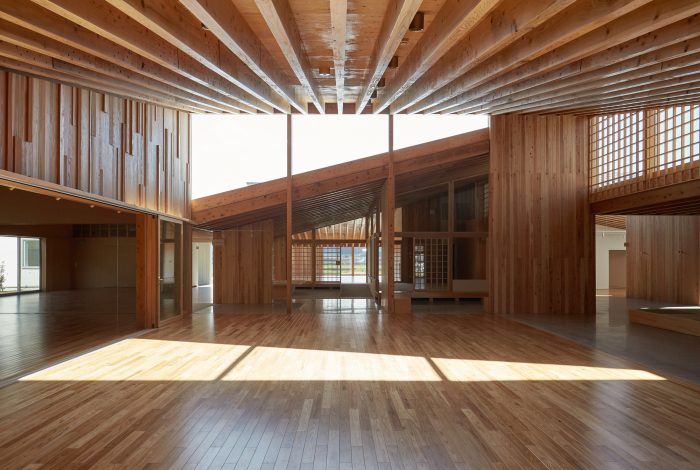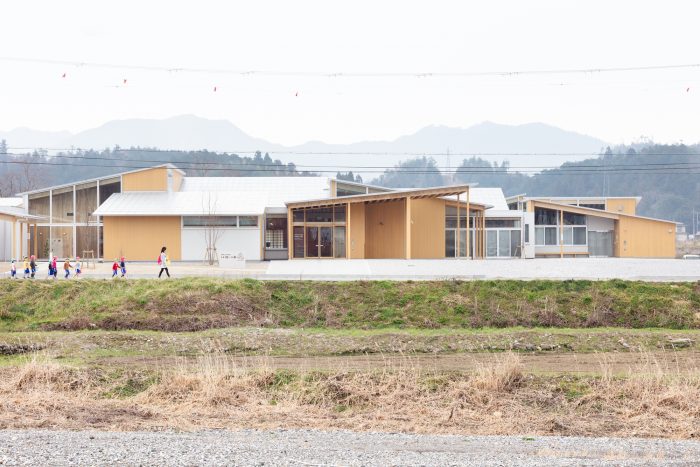本项目是我们在塔加设计的一个2600平方米的木制单层社区中心。它被设想为一个充分利用当地木材的造镇中心。到目前为止,社区中心是作为一个培养和支持当地人自发学习的地方而存在的,其方式与学校不同。因此,我们希望建立一个适合作为人们相互见面、交流智慧、共同学习的场所的社区中心。
Aiming for a New Form of Community Center – This project is a 2,600 square meter wooden single-story community center that we designed in Taga. It was envisioned as a town-making hub that fully utilizes local lumber. Up to this point, community centers have existed as a place that nurtures and supports the local people’s self-motivated learning in a manner that differs from schools. Therefore, we wanted to create a community center that will be suitable as a place where people meet each other, exchange wisdom, and learn together.
现有的社区中心的主要用途是出租房间,供固定的社区成员使用。但是,由于我们希望从来没有使用过社区中心的人能够漫无目的地在这个新的社区中心停留,所以我们为人们创造了各种大大小小的场所,不仅仅是房间,还包括公共区域。每一个房间都以 “飞雁 “的格局摆放在花园的两边,连接房间的走廊上,穿插着供人休息的长椅,供人交谈的桌子,还有小厨房。
The main use for the existing community center was rentable rooms used by a fixed group of members of the community. However, since we wanted people who had never used a community center before to wander aimlessly and stop by this new community center, we created various large and small places for people to spend time, not just in rooms, but also in common areas. Each room is placed in a “flying geese” pattern on either side of the garden, and the corridors connecting the rooms are interspersed with benches for resting, tables for conversing, and small kitchens.
这种飞雁的格局和走廊的迂回,在滋贺附近的传统大型私宅中也能找到。由于各个房间通过走廊和阳台相互连接,这里和那里的光照和阴影创造了令人印象深刻的空间时刻。各种储藏室的位置也防止了火灾,同时与花园保持着宽松的关系。
This flying geese pattern and the meandering through the corridors can be found in traditional large private houses nearby in Shiga. As various rooms are interconnected by corridors and verandas, impressive spatial moments of light and shade are created here and there. The placement of various storehouses also prevents fires, while maintaining a generous relationship with the garden.
为了充分利用当地生产的建筑材料,而不是使用大量的工程木材,设计是基于当地可以采购的材料和尺寸。因此梁的深度以300mm为上限,所有的构件都是将不超过4m的木材构件连接成较长的梁,形成一个最大跨度超过10m的大空间。采购木材需要2年多的时间,看着山里的树木被砍伐,用铁丝吊起来运出去,最后加工成木材,给我们留下了深刻的印象。因为这些在山里养育了几十载的树木,被用于建造一座以山为背景的建筑。
In order to make full use of locally produced building materials, instead of using mass engineered timber, the design was based on materials and sizes that can be procured locally. The depth of the beams was therefore capped at 300mm, and all members were made by connecting timber members no longer than 4m into longer beams to form a large space of over 10m maximum span. More than 2 years were needed to procure the lumber, and as we watched trees being felled in the mountains, hung and carried out by wires, and ultimately processed into lumber, it made a big impression on us. As the trees that were nurtured over tens of years in the mountains, were being used in construction of a building that has the same mountains as its backdrop.
采购材料的时间,也是我们与当地人交流的时间,思考社区中心应该如何建设。在3年半的时间里,我们每个月都会召开一次名为 “我们来谈谈塔加会议 “的会议,当地不同年龄、不同职位的人,镇上各部门的办公室成员,以及镇上博物馆、图书馆的员工都自愿参加。虽然一开始只是一个会议,但却促成了一系列的活动和项目。比如举办名为 “美食节 “的活动,分享塔加第二年的美食;为残疾人举办名为 “马尾笋工场 “的新工作项目;利用当地生产的材料制作家具,成为当地的一个产业。我们相信,在社区中心建成之前,我们一起坐下来,发挥想象力思考如何使用它,在开业活动中,明显地成为了空间的使用方式。
The time that it took to procure the materials also served as time to speak with people in the region and think about how the community center should be. For 3 and a half years, we held a monthly meeting called the “Let’s Talk About Taga Meeting,” in which local people of various ages and positions, town office members across departments, and employees of museums and libraries in the town voluntarily participated. Although it was a meeting at first, it led to a series of events and projects. For instance the hosting of an event called the “Food Festival” to share the cuisine of Taga in its second year, a new work project called the “Horsetail Shoot Workshop” for the disabled, and furniture fabrication using locally produced materials as a local industry. We believe the fact that we sat down together before the completion of the community center and used our imagination to think about how it will be used, became evidently how the space was used during the opening event.
开幕式当天,可能是多贺镇有史以来人数最多的一天。”让我们说说多贺会议 “的妈妈们开了一天的咖啡馆,高中和小学的志愿者们负责活动,许多团体在大厅里进行了15分钟的演讲,当地大学生举办了摄影展,马尾笋工作室的作品在走廊里展出,幼儿园里为孩子们讲故事。在全镇人民的努力下,社区中心的理想愿景在一个个如梦似幻的日子里得以集中实现。
路易斯-卡恩曾说过,建筑的美妙是通过 “人的共识 “意识产生的。即使在我们这一代,也应该有一种生产建筑的方式,让人们感觉到人类的共识是一种推动新建筑的力量。我们希望继续进一步探讨这个问题。
On this day of the opening, a mass of people, possibly the most people the town of Taga had ever seen, visited the community center. the mothers from the Let’s Speak About Taga Meeting ran a cafe for the day, volunteers from high school and elementary school took charge of the event, many organizations gave 15-minute presentations in the hall, local university students hosted a photo exhibition, the works from the Horsetail Shoot Workshop were displayed throughout the corridors, and storytelling was held for children in the nursery. Thanks to the efforts of the people in the town, the ideal vision of the community center was concentratedly realized in one dream-like day.
Louis Kahn once spoke about the wonderfulness of architecture being produced through the sense of “human agreement.” Even in our generation, there should be a way of producing architecture that makes people feel like human agreement is a force that drives new architecture. We would like to continue to explore this further.
建筑师:Onishimaki + Hyakudayuki Architects
面积:2710平方米
年份:2019年
摄影:Takumi Ota, Kai Nakamura
建筑师:Onishimaki + Hyakudayuki Architects
城市:Taga
国家:日本
Architects: Onishimaki + Hyakudayuki Architects
Area: 2710 m²
Year: 2019
Photographs: Takumi Ota, Kai Nakamura
Architect In Charge:Onishimaki + Hyakudayuki Architects
City:Taga
Country:Japan

